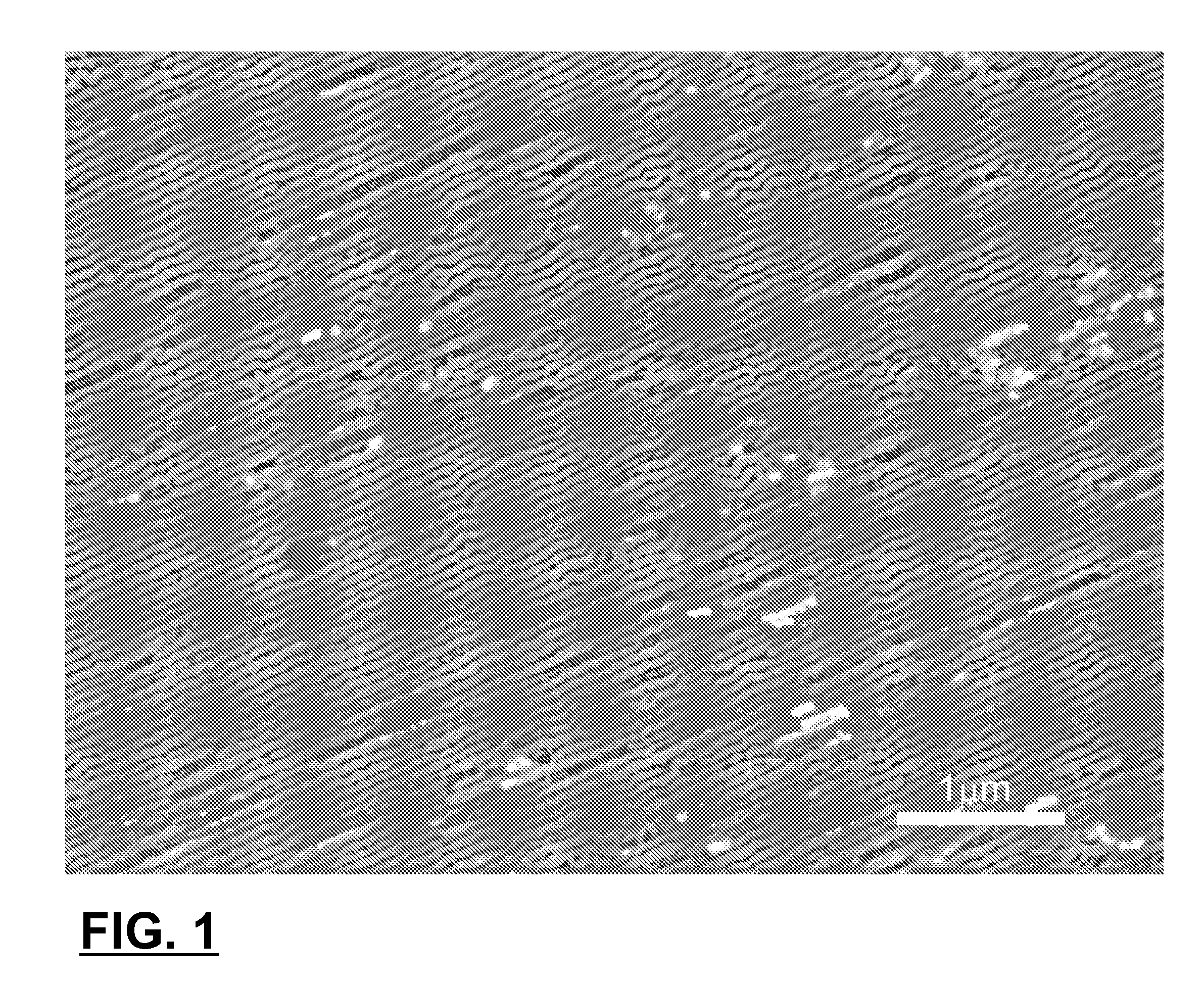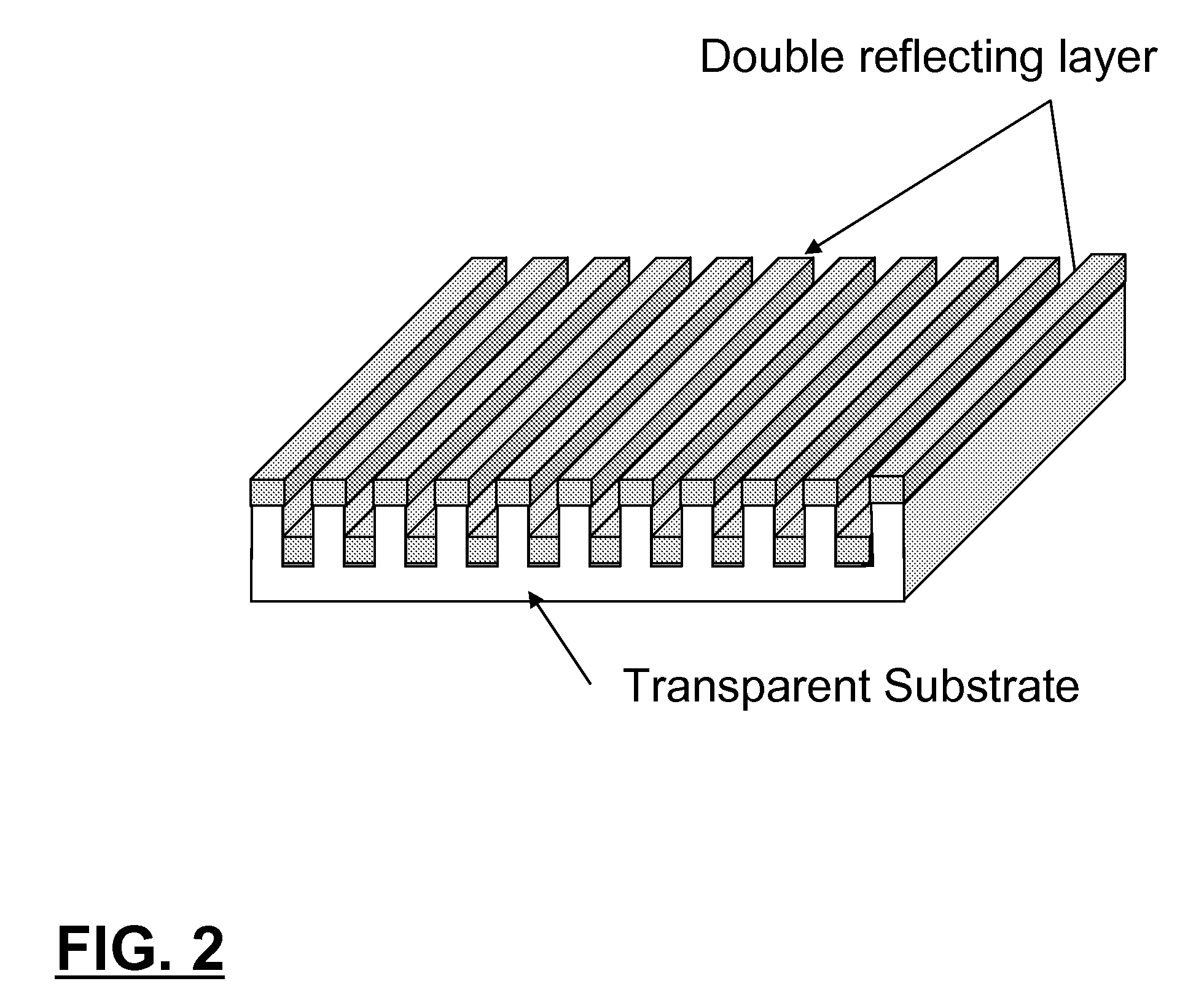Short-wavelength polarizing elements and the manufacture and use thereof
- Summary
- Abstract
- Description
- Claims
- Application Information
AI Technical Summary
Benefits of technology
Problems solved by technology
Method used
Image
Examples
example 1
[0097] Polyimide (Durimide™ 285, Arch Chemicals, Inc., diluted to 3 wt % in gamma-butyrolactone) was spin coated at 1500 rpm for 45 seconds onto a 4-inch-diameter amorphous quartz wafer (AQ: Asahi Glass Co., Ltd.) to form an organic polymer layer. The resulting film, 100 nm thick, was then heated at 90° C. for 30 minutes, and at 150° C. for another 30 minutes, to evaporate residual solvent and crosslink the polymer.
[0098] Next, silicon nitride was deposited using plasma-enhanced chemical vapor deposition. The deposition was performed at 150 sccm of N2, 110 sccm of SiH4 / N2 and 2 sccm of NH3 maintained at 900 mTorr, ignited with 20 W (80 mW / cm2) and lasting 75 seconds, for a final silicon nitride layer thickness of 22 nm. This inorganic substance layer serves an etch barrier in subsequent processing.
[0099] Next, a film of polystyrene-poly(n-hexylmethacrylate) diblock copolymer was deposited by spin-coating from a 1 wt % solution in toluene, at 2500 rpm for 45 seconds. The molecular ...
example 2
Double Layer Polarizer
[0104] In this example, the same process was done as in Example 1 until the O2 RIE. Then, the amorphous quartz wafer was etched using CF4 RIE, at 10 sccm, 15 m Torr pressure, and 100 W of RF power (0.4 W / cm2) for 50 seconds. The amorphous quartz was engraved 70 nm as a pattern of ridges located beneath the original locations of the polystyrene cylinders.
[0105] All of the organic substances were removed by immersing the assembly in 1-methyl-2-pyrrolidinone and sonicating for three times, and by oxygen plasma ashing.
[0106] Aluminum was then deposited onto the resulting striped pattern using an electron-beam evaporator, for an aluminum film thickness of 40 nm, to complete the double layer polarizer.
example 3
Finer Stripe Pattern Manufactured by Metal Staining Method
[0107] In this example, 3 wt % propyleneglycol monomethylether acetate (PGMEA) solution of poly(4-hydroxystyrene) (ALDRICH) was spin coated at 2000 rpm for 45 seconds onto a 4-inch-diameter amorphous quartz wafer to form an organic polymer layer. The resulting film, 80 nm thick, was then heated at 120° C. for 90 seconds to evaporate residual solvent.
[0108] Next, silicon was deposited using an electron-beam evaporator and the resulting thickness was 10 nm. Then, a film of polystyrene-poly(ethylene-alt-propylene) diblock copolymer was deposited by spin-coating from a 0.75 wt % solution in toluene, at 2500 rpm for 45 seconds. The molecular weight of the polystyrene block was 5,000 g / mol and that of the poly(ethylene-alt-propylene) block was 13,000 g / mol, so that the morphology of the film involved cylinders of polystyrene in a matrix of poly(ethylene-alt-propylene), with a period of 16 nm. The resulting thickness of the block ...
PUM
 Login to View More
Login to View More Abstract
Description
Claims
Application Information
 Login to View More
Login to View More - R&D
- Intellectual Property
- Life Sciences
- Materials
- Tech Scout
- Unparalleled Data Quality
- Higher Quality Content
- 60% Fewer Hallucinations
Browse by: Latest US Patents, China's latest patents, Technical Efficacy Thesaurus, Application Domain, Technology Topic, Popular Technical Reports.
© 2025 PatSnap. All rights reserved.Legal|Privacy policy|Modern Slavery Act Transparency Statement|Sitemap|About US| Contact US: help@patsnap.com



